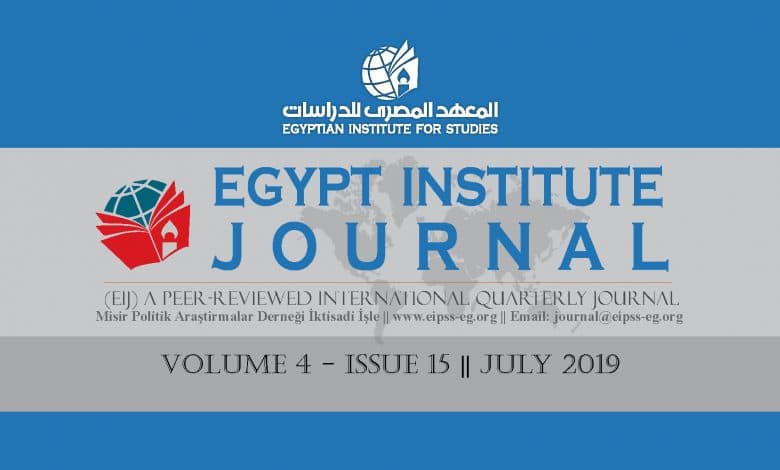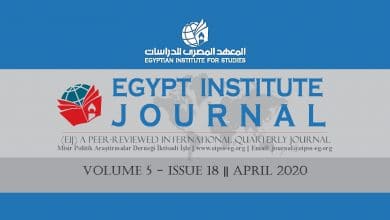
Egypt Institute Journal (Vol. 4 – Issue 15)
Introduction
Issue No.15 of the Egypt Institute Journal, published in July 2016, included a number of political, strategic, economic, intellectual and legal articles, as follows:
1- ‘Role of Social Sciences in Combating Violent Extremism’, by Jalal Khushaib (Algeria)
This paper addresses the founding roots of violent extremism and terrorism in the Islamic world, based on the ideas that Malik bin Nabi found in his books, in attempt to prove the hypothesis that: There is a direct relationship between social sciences and the phenomenon of violent extremism. The more the impact of social sciences prevails in a society, the less its members are likely to embrace or practice extremism, and vice versa. The paper also attempts to answer the following questions:
What are the most important theoretical approaches in studying the causes of violent extremism and terrorism?
How far can these approaches explain the phenomenon? Did they provide radical solutions for it?
What is meant by the ‘world of ideas’ according to Malik bin Nabi and what is its relationship to the phenomenon of violent extremism or terrorism?
What are the sciences that fuel emergence and enhancement of these pathological phenomena, and what are the sciences that help prevent them? How and Why?
What is the relationship between the academic specialization of an individual and his way of thinking? What does this have to do with the phenomenon of violent extremism?
How does the intellectual structure of the societal environment contribute to the emergence of phenomena of violent extremism and terrorism? What are the institutions contributing to this?
How is the “terrorist’s mind” structured?
2- ‘Crises of Saudi regime between Continuity and Change’, by Amjad Ahmed Jibril (Palestine)
Since the launch of Vision 2030 more than three years ago, controversy has escalated over the fate of the “transitional phase” that the Kingdom of Saudi Arabia is going through. While some argue that the transitional phase will end with implementation of Vision 2030 despite the difficulties and challenges facing it, which means success in formulating “public policies” on sound foundations, leading to the solution / reduction of crises in the country. However, others argue that Vision 2030 is not qualitatively new for the overall policy-making process in Saudi Arabia, that remains governed by a set of structural determinants / constraints, which in turn reflects the regime crises, whether inherited from previous eras or emerging during the reign of King Salman.
In this context, the study attempts to answer a major question: How did the Saudi regime’s crises affect public policy making during the reign of Salman bin Abdul Aziz, especially after his son Mohammad took over as Crown Prince in mid-2017?
Thus, the crises of the Saudi regime are considered the independent variable in this study, while the policy making process is considered the dependent variable.
3- ‘Militarization of Civil Ministries in Egypt: The Case of Education Ministry’, by Amgad Hamdi (Egypt)
The study addresses militarization of the education sector in Egypt, which began with the armed forces’ establishment of private schools and the military medical school, and the technological school; in addition to militarization of the Ministry of Education’s leading positions, supplying school student meals, and supervising the Cairo University Hostel’s kitchens by the armed forces’ national service sector. Meanwhile, the Armed Forces Engineering Authority (AFEA) has supervised construction of Japanese schools, in addition to AFEA’s building of 257 model schools with a total of 3520 educational classes in 18 governorates. Also, AFEA is now building 225 schools for the educational building authority, including 98 schools in Upper Egyptian governorates. AFEA has also constructed 100 schools with a total of 1668 classes in 17 governorates, funded by the United Arab Emirates.
4- ‘Lebanese Hezbollah: Challenges of Reality and Future Tracks’, by Badria Al-Rawi (Lebanon)
In light of the pursuit of some resistance groups, such as Hezbollah of Lebanon, to achieve additional goals beyond their primary role, their weapons and agendas have become a problem for regional and local parties. Hezbollah does not hesitate to fight battles against people in its own country or in the neighboring countries. What are the justifications for such acts? What are the functional roles played by Hezbollah through participation in these battles?
5- ‘Lone Wolves: Operations and Confrontation Strategies’, by Alaa Adel (Egypt)
The study of the tactic of the “lone wolf” within the jihadist state in isolation from the general context of this phenomenon may lead to false conclusions; therefore, a careful understanding of this term requires profound anatomy, including exploration of its background and historical roots and discussing the linguistic controversy around it among researchers.
The paper concludes that despite all the weaknesses and modest results of the ‘lone wolf’ tactic, in light of its high cost, the jihadist lone wolf attacks pose an unavoidable threat, whether due to the increasing number of targeted countries from the 1990s until the new millennium, or the number of victims that are killed or injured as a result of lone wolf attacks.
6- ‘Fighting Poverty: Development of Institutional Capacities of Civil Society’, by Dr. Manal Talaat (Egypt)
The study starts from the hypothesis that this stage of the Arab societies’ development is of particular complexity, where problems and rifts multiply as a result of the underlying economic crises. The study concludes that the intervention of civil society institutions contributes to improving the living conditions of the poor classes. The study confirms the need to develop the institutional capacities to confront societal problems such as poverty, marginalization and the absence of social justice, the need to develop the internal work systems of civil society organizations and achieve more networking and alliances between them.
7- ‘Informal Economy in Egypt: Problems and Solutions’, by Mohamed Ahmed Abbas (Egypt)
Since 2015, Egyptian government has announced several initiatives to integrate the informal economy into the country’s formal economy. To achieve this goal, five-year tax breaks as well other incentives have been declared by government officials more than once during this period. The paper is divided into six parts, namely: a- Definition of informal economy. b- Size and nature of informal economy. c- Reasons behind the expansion of informal economy. d- The negative effects of informal economy. e- The positive side of informal economy. f- Egyptian policies for the integration of informal economy (2015-2019).
According to the article, reasons behind the expansion of informal economy in Egypt include bureaucracy, which has become a characteristic of all government institutions in Egypt, corruption (In 2014, Egypt occupied the 94th. position out of 175 countries, according to the Transparency International’s Corruption Perceptions Index. In 2015, Egypt’s ranking improved to 88th, where much of this improvement was due to the fact that the number of countries covered by the report was only 168 countries, compared to 175 countries in 20114. However, in 2018, Egypt ranked 105 out of 180 countries), inefficient tax system (The tax system in Egypt suffers from chronic problems, including its laws and regulations, and the process of collecting taxes.), disruption of the labor market environment (The labor market environment in Egypt has experienced many disturbances since 2011, that escalated sharply since 2013).
The study recommends facilitating business registration procedures, making comprehensive legislative reforms, reforming the tax system in Egypt, encouraging banks to grant loans to integrated projects, establishing trade unions or cooperatives for workers of the informal sector, raising salaries of civil servants, enhancing the role of municipalities in the control of random labor and street vendors, rehabilitation and training of workers of the informal sector, and opening up new markets for the marketing the informal sector products.
8- Fifth Domain – Cyberspace: Development and Hegemony Policies
The study starts from the fact that the four known domains of the traditional armed confrontations between countries (land, sea, air, and space) are no longer alone on the international scene, with the emergence of a fifth domain of confrontation, namely, the cyberspace, where cyber war is expected to be the dominant feature, if not the main feature of future wars in the twenty-first century.
The danger of Internet and network wars lies in the fact that the world is becoming more and more dependent on Cyberspace, especially in the military, banking and governmental information infrastructures as well as public and private institutions and companies.
The interest of world countries, especially the developed ones, in the fifth domain, the cyberspace, especially in establishing armies capable of defending vital State institutions, makes the fifth domain occupy a large part of the countries’ policies and in their future strategies.
9- Ideological Conflict and Division within ISIS
The waning of the Islamic State in Iraq and Syria (ISIS) in the field of ground fighting, the fall of its strongholds in Iraq and Syria, and the death of most of its leaders are not the only manifestations of a crisis that is ravaging the ranks of the militant organization and threatening its existence. In fact, the cracking in ISIS ideological structure and the sharp division among its leaders, Sharia theorists, preachers and soldiers is the most prominent manifestation of this crisis, especially, that this division was not due to different jurisprudential, strategic or organizational stances or views, but it was due to a conflict in ideological and methodological convictions.
The paper attempts to approach this thorny topic in the light of the following questions:
– What are these differences about and when did they arise within ISIS?
– What are the ideas and convictions of the rival streams?
– What are the causes, background, dimensions and manifestations of this division?
– What is the attitude of Abu Bakr al-Baghdadi towards this dispute?
The study aims to shed light on a corner of the Islamic State as long as the militant organization wants it to remain in the shadows, in order to preserve the coherence of its structure and unite its supporters and followers, namely, the ideological conflict and rift between its leaders.
10- Features of Taliban Political Project
The study is based on three main premises in its attempt to understand the Taliban movement’s political project; the first, the fact that Taliban’s entry into the world of politics was spontaneous after its control of power in Kabul and was not preceded by any academic theoretical study or political ideology from the Taliban leaders; the second, the fact that there was no significant change in the core of the movement’s project, which is to adhere to the independence and Islamic nature of Afghanistan, but Taliban has become more aware of regional and global political reality and has developed its performance and tools in dealing with it; and the third, is the fact that there was evident change in the movement’s policy with respect to the social and media aspects.
Egypt Institute Journal (Vol. 4 – Issue 15) link
To Read Text in PDF Format Click here.



